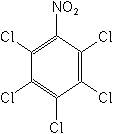-
Common NameQuintozene
-
中文通用名五氯硝基苯
-
IUPACpentachloronitrobenzene
-
CASpentachloronitrobenzene
-
CAS No.82-68-8
-
Molecular FormulaC6Cl5NO2
-
Molecular Structure
-
Category
-
Activity
Fungicide
-
PremixThiram+quintozene
Amicarthiazol+thiram+quintozene
-
Physical PropertiesMolecular weight:295.3g/mol;Physical form:Colourless needles; tech., pale yellow crystals). Density:1907 kg/m3 (21 °C); Composition:Tech. grade is 99% pure. Melting point:143-144 °C; tech., 142-145 °C); Vapour pressure:12.7 mPa (25 °C); Partition coefficient(n-octanol and water):logP = 5.1; Solubility:In water 0.1 mg/l (20 °C). In toluene 1140, methanol 20, heptane 30 (all in g/l).Stability:Stable to heat. Stable in acidic media, but hydrolysed by alkalis. Some surface colouring after 10 h exposure to sunlight.
-
ToxicologyOral:Acute oral LD50 for rats >5000 mg/ kg.Percutaneous:Acute percutaneous LD50 for rabbits >5000 mg/kg.Not irritating to skin;slightly irritating to eyes (rabbits). Inhalation: LC50(4 h) for rats >1.7 mg/l.ADI:0.2 mg/ kg.
-
Environmental ProfileEcotoxicology:
Birds LD50for mallard ducks 2000 mg/kg. Dietary LC50(8 d) for mallard ducks and bobwhite quail >5000 ppm.Fish LC50(96 h) for rainbow trout 0.55, bluegill sunfish 0.1 ppm.Daphnia LC50(48 h) 0.77 mg/l.Other aquatic spp. LC50(96 h) for shrimps 0.012, oyster 0.029 ppm. Bees LD50(contact) >100 g/bee.
Environmental fate:
Animals:In mammals, the major routes of elimination are as unchanged material in the faeces or as metabolites in the urine. In rats, sheep and monkeys, the principal metabolite is pentachloroaniline (formed by reduction of the nitro group). Other metabolites inclSoil:Persists in soil, with a half-life of c. 4-10 months. Part is lost from the soil by volatilisation. Biodegradation occurs, mainly to pentachloroaniline and also methylthiopentachlorobenzene. For details of effects on soil organisms, see E. R. IngPlant:In plants, quintozene undergoes conversion to pentachloroaniline, methylthiopentachlorobenzene and a variety of chlorophenyl methyl sulfoxides and sulfones. -
Transport InformationHazard Class:III(Slightly hazardous)
Porduct NewsMore
APVMA extends suspension of fungicide quintozene
Canada to continue register fungicide quintozene

 0
0 Subscribe
Subscribe
